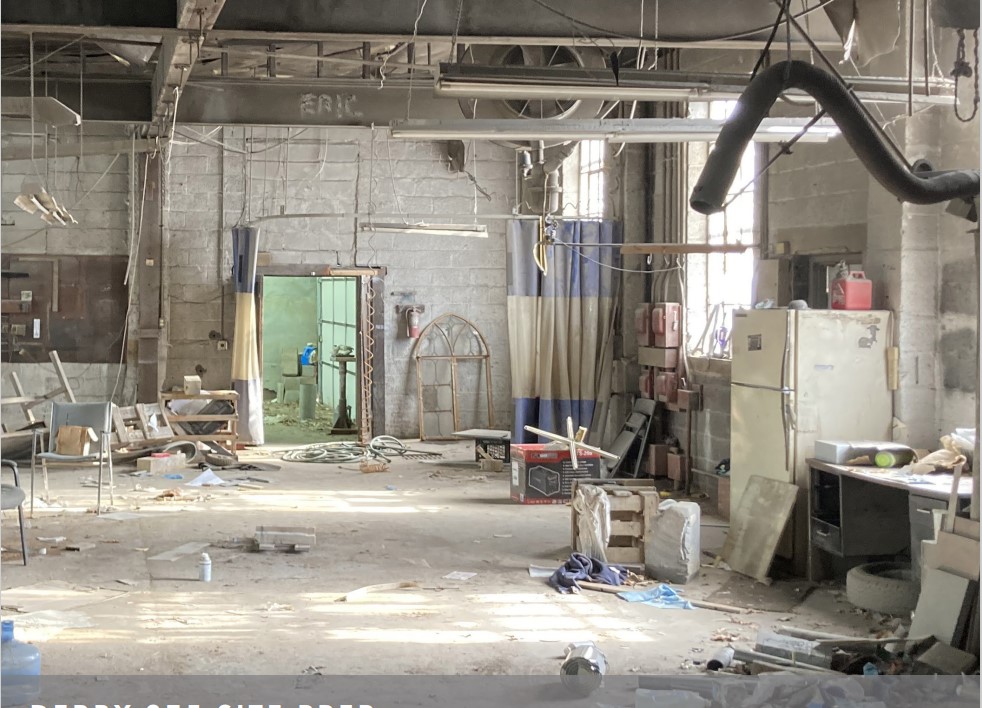
Yale – Lapham Field House Demo
231 Derby Ave. New Haven, CT 06511
Consigli Project # 2881
Emergency Response Plan
ALL EMERGENCIES SHOULD BE REPORTED BY CALLING 9-1-1
SITE INFORMATION
This Emergency Response Plan (E.R.P.) is specifically developed for Consigli Construction work associated with this project.
SITE LOCATION
The construction site is located at 231 Derby Ave. New Haven, CT 06511. The location for the project field office is currently at the Project jobsite (notifications of any changes will be provided). When determined, the field office will become the Emergency Operations Center (EOC).
EMERGENCY TYPE
The following situations are considered emergency response actions and should be handled in accordance with the procedures outlined in this plan.
- Serious Injury/Fatalities
- Fire/Explosion
- Structural Damage/Collapse
- Weather or Geological Event
- Environmental Incident
- Traffic Disruption
- Utility Damage
- Illegal Activity
- Labor Problems
- Bomb Threats/Military Ordinance Unearthing
- Acts of Terrorism
When reporting an emergency, please provide the following:
• Your location, phone number, and name;
• The location of the incident (building name, floor and room number);
• Nature and extent of the incident (injury, accident, spill, smoke/fire, damage, etc.);
• The safest route to the incident.
Crisis Response Protocol:
- Attend to the injured
- Immediately contact Bryan Kingsbury (508)808-9359
- Post person at front gate, only allow access to emergency responders
- Record names/addresses of witnesses
- Do not allow media on site
- Refer all media inquiries to home office (See Consigli “Crisis Response Cards”)
A Consigli designated individual shall wait at the job site entrance to escort Emergency Services personnel as they arrive.
The following is a list of the Chain of Command/Call Hierarchy on the project for establishing lines of succession during communication involving all emergencies. The following is a list of the Chain of Command/Call Hierarchy on the project for establishing lines of communication for all emergencies.
Back– End of Emergency Response Plan
Emergency Contact Names and Numbers
First call: 911 Fire or police
2nd Call: Consigli Project Superintendent: Steve Flick (203) 410-8613
3rd Call: Consigli Project Manager: Corey Shearer (774)462-1264
4th Call: Consigli Asst Project Manager: Mike Lanouette (860)214-8970
5th Call: Consigli Safety Director: Bryan Kingsbury (508)808-9359
ADDITIONAL PROJECT CONTACT NUMBERS
- Consigli General Superintendent: Ed Oloff (774)573-0411
- Consigli Project Executive: Victor Ciancetta (860)331-1159
- Consigli Regional Safety Manager: Ed Robinson (845)518-4897
- New Haven Police: Non-Emergency (203)946-6316
- New Haven Fire Department: Non-Emergency (203)946-6300
- Yale OPM: Michael Douyard (475)414-3548
Back– End of Emergency Contact Names and Numbers
Medical Facilities
Occupational Health: Concentra Urgent Care
370 James St. Suite 304 New Haven, CT 06513
(203)503-0482
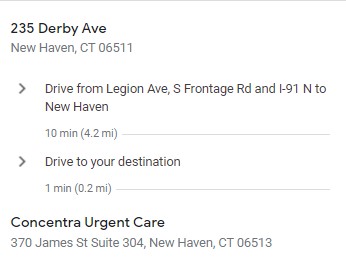
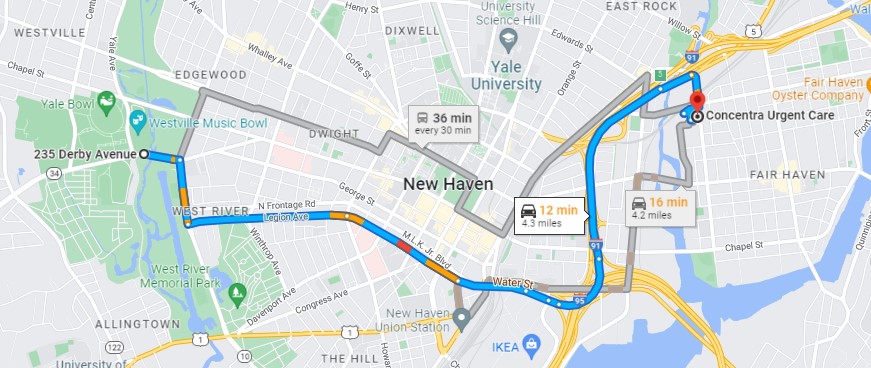
Yale New Haven Emergency Department
20 York St. New Haven, CT 06510
(203)688-4242
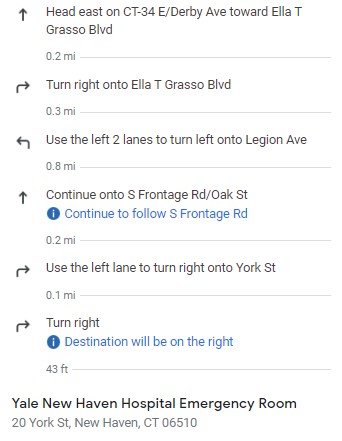
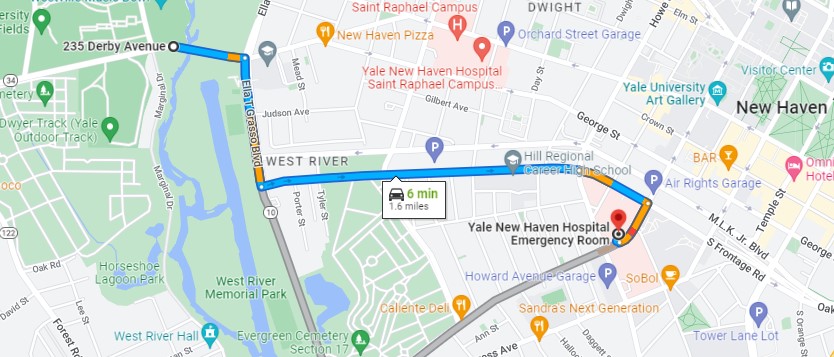
In case of emergency a Consigli representative will be dispatched to the Main entrance of the building/site to meet the responding Emergency Personnel and advise the individual in charge of the location of any chemicals or hazardous substances that may be present on any of the floors. SDS sheets will be readily available if needed by the Fire Dept.
In the event of a serious injury requiring the assistance of Local EMS the injured worker will be kept as comfortable as possible. Emergency first aid if necessary will be administered. Under no circumstances will the injured person be moved unless the worker’s life is in danger because of fire or calamity. A worker will be assigned to meet the medical personnel at the above location to direct them to the location of incident.
In the event an evacuation is required all personnel at this job site will assemble at the designated Muster Point (see below). The Muster Point location may change due to phases of the project. The foreman for each company will meet at that location and take a head count of their staff and report to Consigli Superintendent. If for some reason a worker is unaccounted for, the fire department will be notified of the last location where the worker was observed.
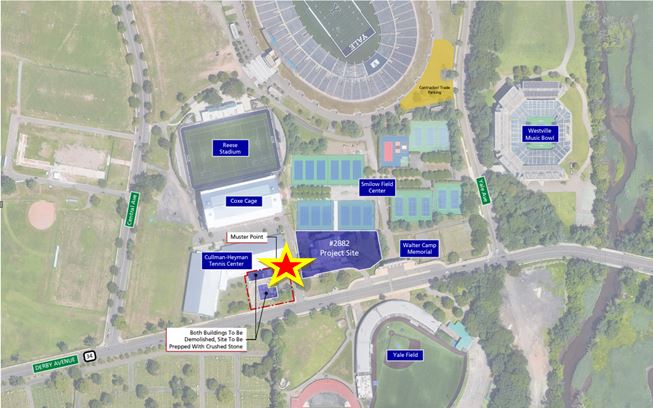
Back– End of Medical Facilities
Site Safety Plan
Scope of Proposed Operations: Beginning in the Winter of 2023 the Yale – Lapham Field House Demo project includes demolition of existing structures on the property at 231 Derby Avenue. The existing property includes two empty building structures of approximately 12,400 sf and various yard equipment that was part of the former Giordano Monuments Company. The single story building fronting Derby Avenue is a wood framed structure that was used as a showroom and sales office for the prior business. The rear building was used for monument manufacturing and is a tall, single-story structure constructed of CMU walls with a combination of steel beams and wood timbers that provided a robust structure for overhead support of the monuments. Both buildings are concrete slab-on-grade construction. There is an assortment of old furniture, mechanical and electrical equipment, and miscellaneous storage items throughout the two structures and in the former service yard. Future site use has not been determined, and it is understood that it may be used as staging and lay down space during construction of the Lapham Field House project. There is a large steel frame billboard that sits on top of the showroom building and a large, 3-legged steel gantry crane in the service yard that is understood to be removed by Yale prior to this project.
Purpose: The purpose of this Site-Specific Safety and Health Program is to illustrate Consigli’s approach to identifying project specific hazards and controls and how risk is managed through a comprehensive Safety and Health Program.
S.A.F.E.: Staying Accident Free Every Day: Is the Safety Mission that forms the very foundation of the Consigli Safety Culture. The S.A.F.E. mission, which is supported by technology, (Predictive Solutions internal auditing instrument which identifies and defines leading indicator related information); Leadership (Empowering our team members to assure safe projects); Humanization (Protect the ones you love by protecting yourself); Jobsite Gym (Morning warm-ups); Training (Integrating sub-contractors into the Consigli Safety Culture); and Lean (nothing hit the ground), is the driving force behind Consigli’ s drive to our vision – ZERO. ZERO is the philosophy that all accidents are preventable and that no accident is acceptable. The S.A.F.E. mission is the guiding force to achieving the Consigli Safety Vision which is ZERO.
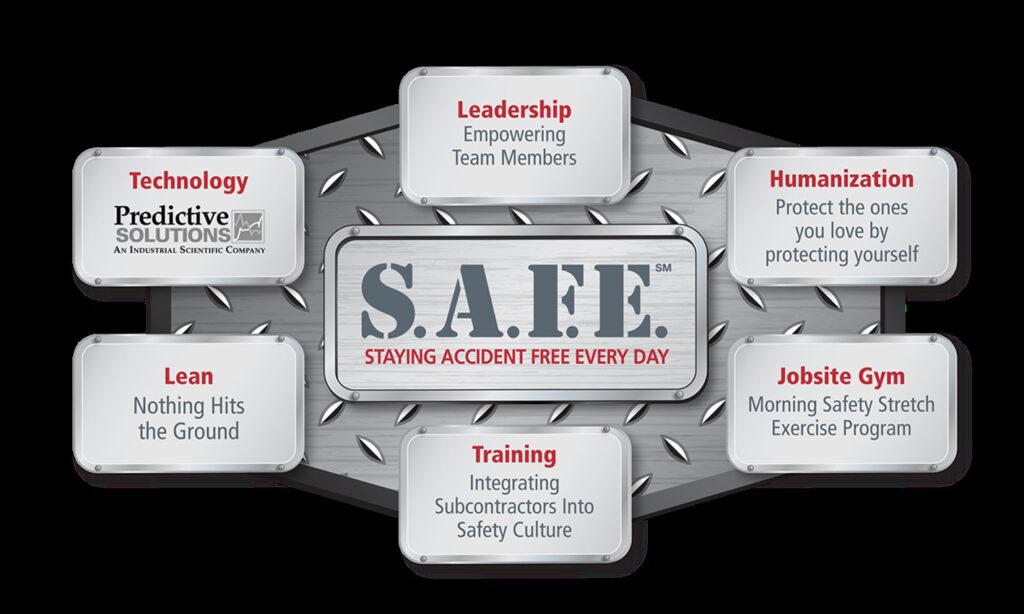
Identify the specific route in and out of the construction site (Traffic Management): All deliveries and waste removal shall be done using the pre-determined entrance communicated to contractors prior to start. All contractors will be responsible for adhering to New Haven and Yale restrictions and regulations regarding driving, parking and delivering materials. Pedestrians will be always given the right of way. Parking will be permitted in designated areas only.
Designated work hours (any work outside these hours must have prior CCC approval): All work shall take place during business hours, Monday – Friday 7:00am to 3:30pm, any work which may need to take place outside of these hours will need to be approved by the CCC Superintendent.
Job Safety Analysis (JSA): A JSA depending on level of hazard shall be conducted for each identifiable feature of work to be performed. The JSA shall be submitted to Consigli superintendent/supervisor. JSA shall be reviewed weekly, signed by all workers including their supervisor, with all involved personnel performing that particular task.
Post Incident Review: Any incident that results in a recordable injury will require a post incident review. The worker who was injured along with their foreman/Safety Personnel/PM/Sup/etc. will need to fill out Appendix N (post incident review form) and attend this meeting. At this meeting they will re-emphasize their commitment to safety, determine chronology of events, identify contributing factors, identify root cause, provide improvement plan to prevent reoccurrence and discuss disciplinary actions taken (if any). Findings from this meeting will be shared/disseminated with all contractors on site to prevent reoccurrence.
Demolition: Exterior demolition includes some existing site and tennis surfaces. Given the existing interior space, major structural demolition is not expected. Interior MEP/FP demo is expected though. Prior to the start of any demo operations, the contractor preforming demo will confirm that all utilities leading into the area have been made safe. The electrician will disconnect and lock out all electrical, the plumber will do the same with any plumbing lines, and the HVAC subcontractor will do the same on the HVAC piping and duct work. Lock out tag out will be reviewed during the pre-construction safety meetings to assure disconnect and responsibility for protection of existing utilities is safe for any construction activities to commence. In spaces where some electrical or mechanical must remain live, a color-coding system will be utilized for easy identification of live utilities that must stay active and utilities that must be removed. Any and all utilities spray painted Red are not to be touched and need to be protected during all operations. Utilities spray painted Green are to be removed as part of the selective demolition process only after lock-out/tag-out has been confirmed and utilities tested. If any utilities are unmarked, they shall be considered live. The demo contractor will be responsible for completing CCC demo checklist prior to the start of any work in their target areas
Lockout/Tagout, scheduling shutdowns
These procedures shall follow in strict accordance with the OSHA requirements in 1910.147 – Control of Hazardous Energy, NFPA 70E, NFPA 99, etc. Yale Facilities may have procedures already established for this work. In every case, shutdowns of all types are required to be coordinated with Yale Management team and Facilities Staff. At no time will work be performed on any system prior to this meeting taking place.
Excavations: Excavation/Site work will be limited to any work associated with the new utilities required. Required permitting will be obtained before any excavating is to begin. If necessary, tabulated data/engineering for shoring and shielding systems will be obtained and available on site at all times when in use. All excavations will be inspected by a competent person on a daily basis. Written excavation inspections will be done if the excavation exceeds 5’.
- Dig Safe Notification/Call Before You Dig/utility locator – number/report will be posted in office if needed.
- Copies of soil engineering and tabulated data sheets for all trench boxes or other shoring/shielding systems brought on site will be provided to CCC and be kept in construction office.
**Review Chapter 19 for more detail
Fall Protection: All workers exposed to a fall of 6′ or greater shall be protected by guardrails safety nets or personnel fall arrest systems. Fall protection required activities shall include, but are not limited to, Roof work, window removal and replacement, scaffold erection, stair installation, slab demo, and other work at height required for MEP installation. Holes greater than 2” will be covered with acceptable material (3/4 plywood ½ steel) which will be secured and marked hole and capable of supporting 2x the intended load (cover must be able to withstand 2x times the intended load).
Covers will stay in place until the hole/penetration has been filled with duct or Pipe riser which extends above the deck. Building perimeters and mezzanine leading edges shall be protected with cable guard rail system with turnbuckles to be installed for all straight runs and any straight run.
The existing roof is flat. Before any work is to begin on the roof, it must be determined what method of fall protection will be implemented. All workers working on a roof with a slope greater than 4 to 1 and exposed to a fall greater than 6 feet will have fall protection 100%of the time spent in this location. Workers on a roof with a slope less than 4 to 1 may put flagging (six feet for roofers-15 feet for everyone else) lines up, whenever roofers and any other trade are on the same roof then the flagging must be pulled back to the maximum distance. All material will need to be kept a minimum of 6’ from the roof edge, any materials that may be blown off of the roof shall be secured/weighted down.
The use of Safety Monitors is not permitted!!!
**Review Chapter 13 for more detail
Work on Ladders: All work on step ladders/straight ladders will be done correctly per manufacturer’s recommendations. Any worker who is on a step/straight ladder and could be exposed to a fall greater than the height of their work on the ladder will be required to install a form of fall protection. Step ladders will not be used as a form of access to a walking /working level, also all straight ladders will be tied of when installed for use. Only ladders with a rating Type 1A or 1AA will be allowed on Consigli projects.
Aerial/Scissor Lifts: When aerial/scissor lifts are required the area and ground conditions, in the intended work area, will be inspected for overhead power lines, sink holes, covers, or any other unsafe conditions which cause an unsafe incident. Aerial lift platforms will be inspected daily before each shift by a competent person designated. All who will be performing work from an aerial lift will show documented proof of training prior to using the lift. Steel plates or equipment mats will be placed on the ground above any utility/ underground structures if there will be Aerial lifts operating directly over them. Workers will always be tied off when using an aerial lift.
HazCom/Global Harmonization: All Materials and chemicals used on-site will have Safety Data Sheets (SDS) provided before being brought onsite.
- SDS sheets on file in Consigli Construction’s Site Safety Plan
- All SDS sheets shall be readily accessible.
** Please review chapter 20 for additional details.
Fire Protection:
A detailed fire protection plan shall be created for the project to address life safety fire protection and detection. During construction, a Hot Work Permit is required for any activity that generates heat, sparks or has an open flame. This will be coordinated through Consigli as well as Yale and New Haven Fire Department. (as required). All workers involved in hot work activities shall be trained in Hot Work Safety. Any hot work will stop one hour before the regular end of the day work stoppage. Flammables will not be stored inside the building or left overnight on the scaffold or in the building. All combustible or flammable materials will be stored in an appropriately rated lockable cabinet located no closer than 50 feet from the nearest structure.
Fire extinguishers will be provided for every 3000 square feet. They will be installed on job made stands and conspicuously located throughout. They will be part of the daily inspection with extinguisher log completed monthly. Storage of any acetylene cylinders will be done in a secure and upright area, with good ventilation. This will be a strict no smoking project. All penetrations leading outside of the construction area will be fire stopped using approved fire rated material prior to the end of each shift.
**Review Chapter 17 for more detail.
Electrical: All electrical tools, cords and equipment must be in good working order. To that end, all electrical tools and components must be visually checked daily. Any tools with damaged cords or damaged cords must be taken out service… All cords must be equipped with a ground pin, flat three wire cords are not allowed. SJO and SJT or other similarly rated cords only shall be used. The electrician will be responsible for all temp power and any temp lighting that may be needed. They will coordinate all lock out tag out procedures. All temporary power for the project will be installed on protected and dedicated circuits with 100% GFCI protection. GFCI will be tested by the electric contractor weekly to assure proper function with a log book filed with CCC monthly. No live electrical work will be conducted. No live electrical work will be conducted per NFPA 70E.
**Review Chapter 26 for more detail
Utility Exposures: Any overhead power lines will be located and identified prior to use of any equipment which may come in to contact with them. All sidewalks will be protected if equipment is to be driven over them.
Crane: Limited traditional hydraulic crane use expected. Mostly for roof deliveries and equipment removal. All cranes will require independent annual 3rd party inspections. Crane work will be permitted for operation only after detailed lift plans are submitted and reviewed by Consigli. It is anticipated that these cranes will be hydraulic. In the event that a lattice boom crane is utilized (unlikely), then the crane must get an on-site 3rd party inspection once the crane is assembled, prior to operation.
There is a requirement to assure that certified riggers, signalmen, and crane assemblymen are utilized. All picks are to be done by a licensed operator. As previously mentioned, a detailed pick plan will be required to assure that no picks are critical in nature. Critical picks are defined as those involving 2 cranes lifting simultaneously, a pick that is over 75% of capacity, a pick that involves the lifting of a man basket, or any other lift that is deemed to involve special conditions. Location and set up will be reviewed with crane operator prior to set up and pick. All lifting operations will require that the operator and any involved contractors follow the steps listed below as well as in CCC Crane Safety policy.
1. All Hoisting equipment will have a current 3rd party inspection certificate with the equipment which will be copied and filed in the office trailer.
2. All lattice boom cranes will have an independent 3rd party inspection completed each time one is set up on the project, after assembly and prior to operation.
3. All equipment operators will be required to have in their possession all appropriate licensing and training as required by OSHA and the State of CT. All crane operators must be qualified by their employer and documentation of the employer qualification included in the lift plan.
4. All underground vaults and existing utilities will be marked before as well as before any crane is set up.
5. Documented rigging equipment inspections.
6. Documented daily crane inspections filed with CCC weekly.
7. Documented rigger and hand signalman training will be provided.
** Please review chapter 24 for additional details.
Equipment issues: All operators will be required to have in their possession all appropriate licensing and training as required by OSHA and the state of CT. All safety devices and warning alarms must be in good working order and all leaks are to be repaired immediately. All equipment will be used in accordance with the manufacturer’s recommendations for safe usage and have its operator’s manual as well as an extinguisher with it at all times. Subcontractors who will have equipment on site will be responsible for having a spill kit available at all times.
** Please review chapter 24 for additional details
Confined Space: A written plan will be needed to work in any tanks/vaults and crawl spaces during this project which have been designated permit confined spaces by CCC, this plan must include air monitoring. Confined Space entry will be coordinated with Yale and New Haven Emergency Services as well.
** Please review chapter 21 for additional details.
Designated First Aid Plan: All injuries no matter how minor must be reported to Consigli Superintendent immediately. The superintendent will then report all injuries to the CCC Safety Director. A fully stocked first aid kit and blood borne pathogens kit shall be maintained on the project site. Only properly trained personnel will administer first aid. Consigli Construction shall follow Site Safety Plan for first Aid. Report any incidents to the Safety Director.
** Please review chapter 1 and 27 for additional details.
Sanitary Requirements
The amount of sanitary facilities required shall be based on the total number of workers employed on the Project and shall be in accordance with OSHA’s provisions outlined in Table D-1 of 1926.51(c)(1). At a minimum the following shall apply in order to maintain the highest level of sanitary conditions during and up to completion of construction;
- Maintain all units in a clean and sanitary condition.
- At the minimum, clean on a weekly basis, and more often as required by the applicable OSHA sanitary standards for number of workers on the project site.
- Provide all toilet supplies as required, including toilet paper, soap, paper towels, and waste receptors.
Substance Abuse: As a condition of employment, all Consigli personnel are required to submit to a urinalysis test for determination of the presence of illegal substances. A positive result will disqualify the applicant for employment on this project.
Evacuation Plan (RACE, and Routes of Egress): Please refer to the Evacuation Plans attached. All Consigli employees shall attend the Project Safety Orientation. Consigli Construction’s Job Supervisor will conduct a safety orientation talk to each employee and subcontractor to site specific fire safety protocols.
Emergency Management Response: In the event of an Emergency the construction workers shall leave all 3 of the building immediately. Point of assembly/muster shall be located next to the field office trailers. In the Event of a DISASTER, the Superintendent or Safety director shall instruct the construction workers to leave the site or remain in place and await further instruction. The following steps should be taken in the event of an emergency
When reporting an emergency, please provide the following:
• Your location, phone number, and name;
• The location of the incident (building name, floor and room number);
• Nature and extent of the incident (injury, accident, spill, smoke/fire, damage, etc.);
• The name and amount of the material spilled (if applicable); and
• The safest route to the spill (if applicable).
** Please review chapter 8 for additional details.
Minimum Site Safety Requirement: All Consigli workers, and any subcontractors, shall have, at a minimum, an OSHA 10 Hour Construction Safety Outreach training certificate and shall provide documentation of training.
Minimum PPE Requirements
Project Superintendents shall be responsible for assuring that all workers comply with the Personal Protective Equipment requirements.
The Site Safety Manager will periodically audit for field compliance. The Minimum Personal Protective Equipment requirements are as follows:
- All workers will be thoroughly indoctrinated by their respective employer and trained in the proper use of required protective equipment. Defective or unacceptable PPE will be removed immediately from service
- The Yale – Lapham Field House Demo project shall be a Mandatory Hard Hat Job.
- All workers will require 100% eye protection. All overhead work will require the use of either a face shield or pair of goggles in conjunction with safety glasses.
- All workers manually manipulating materials are required to wear gloves that are appropriate to the material manipulating task. Exceptions include lunch, restroom breaks, and office work. In addition to utilizing gloves, the subcontractor employer shall be responsible for training workers into proper use and limitations of the gloves utilized.
- Subcontractors JSA’s need to document hand and finger hazards, and glove selection and use for protecting against said hazard.
- Employees shall be provided with face protection equipment when power tools, machines or operations present potential eye or face injury from physical, chemical, or radiation agents.
- Hearing protection against the effects of noise exposure shall be worn when sound levels exceed 85 dba as calculated by the Safety Manager on site.
- Each subcontractor supervisor shall make available at all times, the proper hearing protection for each worker.
- Respirators/nuisance masks, when needed for sweeping or other dusty conditions are to be provided by each subcontractor supervisor under the OHSA regulation 1910.134 for voluntary use only.
- Impermeable rubber or any impenetrable protection shall be worn to prevent skin contact with any acid, chemical, creosote, coal tar, fuel oil or concrete. This is especially true for Concrete workers and masons.
- 100% High visibility vests shall be worn by workers at all times.
- Metatarsal guards will be used by workers handling tools capable of causing Metatarsal injury.
- Non-skid soles will be worn on safety shoes.
- Long pants are required at all times while on site. They shall be appropriate to the task being performed. Examples of acceptable pants include denim jeans, khakis, twill pants, or work pants. Examples of unacceptable pants include, but are not limited to sweat pants, nylon jogging/wind pants, pajama pants, flannel pants, etc.
- IMPORTANT NOTE: Personnel protective equipment for visitors shall include hard hats, high visibility vest and safety glasses as required.
PPE Training: Necessity, use, limitations, care and maintenance of all provided PPE by a subcontractor supervisor will be conducted upon issue. Said training is to be documented as part of the subcontractor’s toolbox talk meeting process. Retraining of employees by the subcontractor supervisor shall be conducted anytime site conditions change, PPE requirements change, or employee demonstrates improper use or lack of knowledge.
Personal protective equipment, which has been changed in any manner so as to reduce its effectiveness, shall be repossessed, repaired or destroyed. Personal protective equipment worn or used previously by a worker shall not be issued to another employee until the article has been cleaned and sterilized.
NOTE: All subcontractor employers shall be responsible for training all workers on site with the proper use and application of required Personal Protective Equipment.
Restricted Areas:
Contractors are prohibited from entering any adjacent areas of the building unless work has been previously authorized and scheduled. It is important that workers do not park in/in front of adjacent driveways during construction. All workers will try to limit their impact on surrounding areas.
Lean requirements/Materials Management/Housekeeping:
Getting materials into and out of the project will be a challenge that needs to be adequately planned. All deliveries are to be scheduled with the CCC Superintendent. A comprehensive Job Safety Analysis shall be done on all materials that will be hoisted and placed into the building. Only materials which will be used/installed within three days’ time will be delivered to the site. Attention must be paid to structural analysis in regard to loading existing floors with material and equipment. Listed below are additional Lean requirements
- No materials shall be delivered to the site earlier than 3 days before said materials are to be installed/put into place. If materials have to be delivered before that 3-day time period, subcontractor shall get prior approval from Consigli Superintendent. Because of this, notification / scheduling is required for all deliveries to the site. Subcontractors must notify Contractor at least 24 hours in advance. Contractor has the right to refuse any deliveries not properly scheduled or due to logistical constraints as necessary.
- All subcontractors’ delivered materials shall be placed on wheeled carts, wheeled racks or in wheeled bins so as to necessitate easy relocation in the event materials need to be moved. Carts, racks, or dollies shall not exceed manufacturers intended weight loads. Materials/tools can be delivered and stored on pallets only if pallet jacks are delivered simultaneously with said delivery to provide for ready mobility. Additionally, pallet jacks need to remain in immediate area. Each subcontractor will always need to supply their own pallet jacks for their own materials and keep their pallet jack within reasonable distance.
- All work stations shall be provided with wheeled trash bins for immediate placement of all debris produced as a part of the subcontractor’s operations. All trash will be immediately placed in wheeled containers provided by Consigli.
- All subcontractors shall use rubber wheeled carts when moving material or removing trash from a building. Any damage caused by the Subcontractor shall be repaired at the cost of the Subcontractor. Back charges will be appropriately assessed for the cost of the repairs. No trash or materials shall be left on the floor.
- Subcontractors shall, where feasible, elevate all electrical extension cords, hoses, or cables – removing them from all walking/working surfaces. Electrical Cords, when elevated shall be supported or suspended in a manner that does not subject them to damage.
- Storage of delivered materials in cardboard containers shall be discouraged. When materials must stay in cardboard containers, said containers shall be removed from the projects immediately after product is unpacked.
- Subcontractor will participate in schedule development meetings as required by Consigli.
Back– End of Site Safety Plan
Environmental Emergency Contact and Management Response
Consigli identified Emergency Response Subcontractor;
Name: Cyn Environmental Services, Inc. (781)341-1777
100 Tosca Drive Stoughton, MA 02072.
Asbestos: A survey of the work areas shall be conducted by the environmental consultant and detailed in the Hazardous Materials report. The Hazardous Materials report will be reviewed prior to the commencement of demolition and site activities. All ACM shall be removed by a trained/licensed contractor. Asbestos has been identified in the hazmat report(s).
This does not mean that asbestos could not still be found in other areas, caution must be used when working and if any workers identify any potentially hazardous substances then they should stop and notify their supervisor immediately. All identified asbestos will be fully abated by a licensed and regulated asbestos abatement contractor under a formal plan to be written, submitted and in accordance with the DEEP.
IT IS THE RESPONSIBILITY OF ALL SUBCONTRACTOR FOREMEN TO REVIEW THE HAZARDOUS MATERIAL REPORT & CORRESPONDING ABATEMENT REPORT WITH THEIR WORKERS. A copy of the hazardous Material/abatement report will be on site at all times and available to anyone request it. All work and disposal will be done in compliance with state and federal regulations and standards
Lead: A survey of the work areas shall be conducted by the environmental consultant and detailed in the Hazardous Materials report. The Hazardous Materials report will be reviewed prior to the commencement of demolition and site activities.
If any surface is identified as lead containing Consigli workers who will need to perform work on these painted surfaces may need to disturb this paint by drilling, sawing, demo, fastening, or carpentry.
In doing so they will use saws, drills, screw guns, impact wrenches, Sawzall’s, hand wrenches, ads, crowbars, hammers, and other hand tools. Consigli Construction does possess historical data to show that drilling, sawing, light demo, installation of hangers, hanging sheetrock, fastening, and carpentry do not put the employee above the action level. Despite this additional monitoring will be done. An exposure assessment will be done by all subcontractors for all task prior to when the full scale of this work is to take place. This does not mean that lead could not still be found in other areas, caution must be used when working and if any workers identify any potentially hazardous substances then they should stop and notify their supervisor immediately. All workers on this must have completed Lead Awareness training prior to starting on this project. Hand wash stations will be provided to ensure proper hygiene during the project. An exposure assessment will also be done for any task which will disturb any lead containing material.
Silica: Any activity which can produce silica dust will use engineering controls to keep dust to a minimum. A written exposure plan must be developed for all silica producing tasks that clearly defines the following: 1) A description of the tasks in the workplace that involve exposure to respirable crystalline silica; 2) A description of the engineering controls, work practices, and respiratory protection used to limit employee exposure to respirable crystalline silica for each task; 3) A description of the housekeeping measures used to limit employee exposure to respirable crystalline silica; and 4) A description of the procedures used to restrict access to work areas, when necessary, to minimize the number of employees exposed to respirable crystalline silica and their level of exposure, including exposures generated by other employers.
There will be no dry cutting of any masonry material allowed; if water cannot be used then a dustless vacuum system consisting of HEPA dustless vacuum system will be used. Prior to the project going full scale an exposure assessment of a worker grinding and cutting masonry while using the HEPA system an exposure assessment will be done so as to establish the silica exposure level. No respirators will be issued without the express consent of the Consigli Safety department. Nuisance mask like an N95 if used will be on a voluntary basis and at no time will these types of mask be issued to the workers.
Polychlorinated Biphenyl’s (PCBs): At this time there are no activity’s which are planned which would disturb any surface with suspect amounts of PCB’s… This does not mean that regulated levels of PCB’s could not still be found in other areas, caution must be used when working and if any workers identify any potentially hazardous substances then they should stop and notify their supervisor immediately.
Light ballast unless labeled “No PCB’S” will be designated PCB containing, All PCB containing material shall be removed and disposed of in accordance with all local, state, and federal regulations and be coordinated with Yale. All other inquiries or locations in regard to PCB containing material can be located in the Hazardous Material survey. If identified on any of the materials to be impacted, PCB ‘s will be abated. Any and all PCB remediation will be performed by a licensed /qualified contractor
** Please review chapter 29 for additional details
IAQ (indoor air quality):This project may occur in or adjacent to an occupied building. During construction, an indoor air quality plan may be implemented. This plan will ensure that adjoining areas have not been contaminated during construction. The air will be tested for typical indicators such as but not limited to temperature, relative humidity, carbon monoxide, carbon dioxide, dust particulates and VOC’s (volatile organic compounds). Monitoring (frequency/duration) will be done in accordance with a written IAQ plan provided by a Industrial Hygienist. Hard and or poly barriers will be set up between any work areas and occupied spaces prior to the start of any work. Negative air machines will also be used to create a negative air flow from the occupied space to ensure that no dust and debris enter an occupied area. If a hard barrier cannot be set up set up due to an unforeseen condition or emergency, a 6-mil poly barrier will then be used. This will only be allowed after approval from CCC Superintendent and the owner.
** Please review chapter 29 for additional details
Freon/Glycol: All Freon/Glycol materials will be removed from equipment and stored per manufacturer’s recommendations before it is disturbed, moved or removed. All workers who will be working with the above-mentioned materials must provide CCC with certifications or qualifications. If not re-used, a disposal manifest will be provided to CCC.
Mold: Mold issues are not anticipated to be prevalent on this project, however if mold is discovered Consigli’s mold remediation policy will be implemented and followed.
** Please review chapter 22 for additional details
Noise: Noise exposure will be a concern, so all operations must be coordinated with the Consigli Superintendent to limit any excess noise impact on the surrounding areas. All activity or task which may cause load noise will be restricted as needed so as to limit the impact on Guest/Members.
** Please review chapter 29 for additional details
Exposure to the Visitors, Staff and Public: During all phases of construction pedestrian walkways around the project will be open and occupied. Some areas of project will be opened for construction at different times. Any pedestrian walkway under any type of scaffold or overhead hazard will be provided with overhead protection. At no time is any worker allowed to enter any of the adjacent buildings. Non-fraternization with staff, public, and guests will be stressed with all subcontractor personnel during orientations.
Additional Controls: Prior to start of any work, all personnel involved in the project, including project managers must be:
- Trained and orientated by Consigli Construction. Stickers will be issued and displayed on hard hat.
- All individuals working on this project will go through a comprehensive Safety Orientation which will cover all company safety rules regulations and procedures as well as communicating Yale/New Haven specific requirements.
Safety Spot Recognition Plan: The purpose of this plan is to instantly recognize workers “on the spot” for working safely and to reward those workers immediately. This will assist CCC reduce the complacency of workers on all of our projects. Members from the CCC and project teams (Supers, PM, APM, PE, OPM, Architect, Owners, etc..) will be provided with $5 Dunkin Donut gift cards (or similar) prior to their walk on site. They are to present these cards to workers who are working safely and or those taking additional steps to work safely.
After issuing the card, the name and hard hat sticker number of the worker as well as a brief description of what they were doing will be documented in a log that will be maintained in the field office. This shall be completed at a minimum of three times a week. It is required that different field staff take turns in issuing the cards to workers in the field. Also required will be the communication of who is be recognized to other sub-contractors/workers through foreman meetings and daily stand up meetings. At the end of the project the sub-contractor who has had the most workers recognized will receive an appropriate acknowledgment from CCC as well as some type of reward that is to be determined by CCC field staff.
Planning: The project team will meet with the staff before the project start to review any site-specific safety and health requirements. The project team shall be an integrated mix of owner, architect, engineer and Consigli Construction personnel. If, after reviewing programs and meeting with the individuals, the team is satisfied with the risk control direction, personnel will be permitted to begin work.
Incident Reporting
Consigli’s Project Superintendent must be verbally notified by the subcontractor’s supervisor immediately that an accident has taken place and that one or more of his employees has been injured. Any injury, even minor in nature, requiring a visit to an outpatient medical clinic for treatment, must be reported, by the Consigli Superintendent, on the Consigli “Incident Investigation Report” (APPENDIX R).
The Consigli Superintendent must verbally notify the Corporate Safety Manager of any Injury Incident as soon as possible and submit the aforementioned written investigation reports within 24 hours. Maintain a copy of all accident reports on file at the jobsite
Damage to Property: Any property damage accident, whether project property or non-project property, must also be reported on the Consigli Incident Investigation Report Form” (APPENDIX R) as well.
The Consigli Superintendent must verbally notify the Corporate Safety Manager of any damage to property as soon as possible and submit the aforementioned written investigation reports within 24 hours. Maintain a copy of all accident reports on file at the jobsite
Near Misses
A near miss is a potential hazard or incident that has not resulted in any personal injury or property damage. Unsafe working conditions, unsafe employee work habits, improper use of equipment or use of malfunctioning equipment have the potential to cause work related injuries. It is everyone’s responsibility to report and/or correct these potential accidents / incidents immediately.
General Program:
- Any employee can fill out a near miss report (APPENDIX GG) and forward it to the Superintendent to submit to the Safety Department. Please include photographic documentation.
- Each jobsite is encouraged to investigate and report all near misses.
- Near Miss IHTUs will be reviewed at each Quarterly Safety Meeting.
OSHA Reporting Requirements
All OSHA related reporting requirements shall be coordinated through the Regional Safety Manager. OSHA has outlined basic mandated reporting requirements under section 1904 addressing all of the following Accidents;
- Within 8 hours for any job-related fatality
- Within 24 hours following in-patient hospitalization of 1 or more employees within 24 hours of employee amputation or loss of an eye
NOTE: Incidents involving worker injury or property damage must be reported to Consigli’s Safety Department immediately by the project team.
** Please review chapter 9 of Consigli’s Safety and Health Program for additional details
Back– End of Environmental Emergency Contact and Management Response